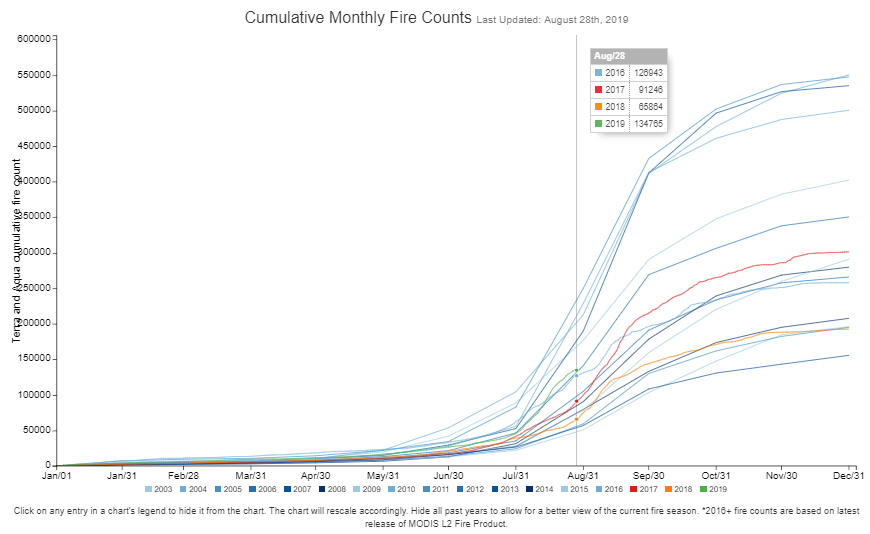Amazon Fires Not Unprecedented: Data Reveal Good News

Fires in the Amazon rainforest have been the topic of a global environmental scare. Some people blame climate change. They say it makes the burn rate worse than usual. French President Emmanuel Macron called it “an international crisis.”
But are we witnessing the rainforest’s death? Are the “lungs of the earth” burning beyond repair?
Not according to the data.
The Amazon rainforest is close to my heart. An avid nature lover, I have spent much time in tropical rainforests. I have always wanted to contribute to their protection.
During my graduate studies, I contributed to conservation efforts in the Amazon. I did a research presentation on conservation of endangered species there. Dr. Carlos Peres, a celebrated Brazilian conservation biologist, called my work noteworthy.
The facts about the Amazonian fires contradict three major claims in the mainstream media.
Are the Fires Are Unprecedented?
A BBC headline read, “Amazon fires: Record number burning in Brazil rainforest—space agency.” But the text cited NASA that the fires are not unprecedented for the whole Amazon: “US space agency NASA said that overall fire activity in the Amazon basin was slightly below average this year. The agency said that while activity had increased in Amazonas and Rondonia, it had decreased in the states of Mato Grosso and Pará.”
Why this contradiction? Simple: while the fires have been below average for the entire Amazon, they have been above in the Brazilian part. The mainstream media ignore this. They have made the public believe that the entire Amazon is in peril.
Instead, current fires in the entire Amazon are close to the 15-year average (2003–2018). There were much bigger fires between 2003 and 2011. As of August 28, total acres burning for the entire Amazon ranked 7th, fewer than 6 but more than 10 other years since 2003.

Image: Cumulative Monthly Fire Count for Entire Amazon, 2019 represented in green. Source: https://www.globalfiredata.org/forecast.html
Does Global Warming Cause or Exacerbate the Fires?
The Los Angeles Times tied the wildfires to climate change. “The Amazon rainforest is on fire. Climate scientists fear a tipping point is near,” read its headline. The article claimed, “Global warming adds to the problem by making the climate hotter and drier, stressing trees and increasing the risk of uncontrolled wildfires that could threaten large areas of forest.”
However, humans cause the fires by means other than climate change.
“The dry season creates the favourable conditions for the use and spread of fire, but starting a fire is the work of humans, either deliberately or by accident,” said a researcher from INPE space agency. The agency provides data on fires in the Amazon.
The New York Times acknowledged, “most of the fires are burning on agricultural land where the forest had already been cleared … by farmers preparing the land for next year’s planting, a common agricultural practice.”
Is the Amazon ‘the Lungs of the Earth’?
Moreover, claims that the Amazon is the source of 20 percent of the world’s oxygen are baseless. In a 2014 in the New York Times, Nadine Unger, Assistant Professor of Atmospheric Chemistry at Yale, dismissed the popular myth.
“The Amazon rain forest is often perceived as the lungs of the planet,” she wrote. “In fact, almost all the oxygen the Amazon produces during the day remains there and is reabsorbed by the forest at night. In other words, the Amazon rain forest is a closed system that uses all its own oxygen and carbon dioxide.”
The fires pose no danger to global oxygen levels or atmospheric greenhouse gas concentrations. They also can’t influence global temperatures. Despite the more severe Amazon fires in the first decade of this century, global warming slowed.
That is good news for a rainforest enthusiast like me.
The two-week long media bombardment created unnecessary hysteria. It also undermined trust in reporting. We deserve better.
In fact, we are fortunate to live when the tropics are covered with rainforests. Before the Holocene Era (8,000 B.C. to the present), “There were no rain forests in the Malay Peninsula and much of Amazonia, and, despite the increasing human development of forest space, there are still more rain forests persisting than existed then,” says Philip Stott, Emeritus Professor of BioGeography at the University of London.
The fires are a common and necessary agricultural practice. “I think the media focus on this is misplaced and exaggerated,” said Dr. Roy Spencer, a climatologist and former NASA scientist who consults on global crop-market forecasting. “The driest years in Brazil will have the most fires set by farmers. … It is normal agriculture in a country where 50 million people living in poverty are trying to survive.”
So the fires are not unprecedented. They’re not caused by climate change. And they don’t threaten to suffocate everyone.
The two-week long media bombardment created unnecessary hysteria. It also undermined trust in reporting. We deserve better.
Vijay Jayaraj (M.Sc., Environmental Science, University of East Anglia, England), Research Contributor for the Cornwall Alliance for the Stewardship of Creation.







